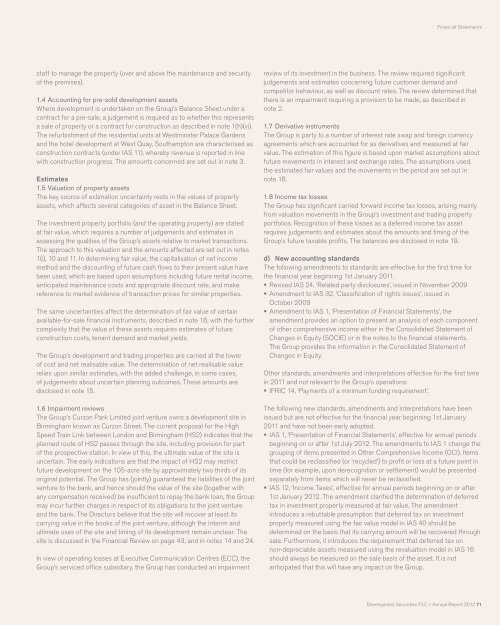Annual Report 2012 - Development Securities PLC
Annual Report 2012 - Development Securities PLC
Annual Report 2012 - Development Securities PLC
Create successful ePaper yourself
Turn your PDF publications into a flip-book with our unique Google optimized e-Paper software.
staff to manage the property (over and above the maintenance and security<br />
of the premises).<br />
1.4 Accounting for pre-sold development assets<br />
Where development is undertaken on the Group’s Balance Sheet under a<br />
contract for a pre-sale, a judgement is required as to whether this represents<br />
a sale of property or a contract for construction as described in note 1(h)(vi).<br />
The refurbishment of the residential units at Westminster Palace Gardens<br />
and the hotel development at West Quay, Southampton are characterised as<br />
construction contracts (under IAS 11), whereby revenue is reported in line<br />
with construction progress. The amounts concerned are set out in note 3.<br />
Estimates<br />
1.5 Valuation of property assets<br />
The key source of estimation uncertainty rests in the values of property<br />
assets, which affects several categories of asset in the Balance Sheet.<br />
The investment property portfolio (and the operating property) are stated<br />
at fair value, which requires a number of judgements and estimates in<br />
assessing the qualities of the Group’s assets relative to market transactions.<br />
The approach to this valuation and the amounts affected are set out in notes<br />
1(i), 10 and 11. In determining fair value, the capitalisation of net income<br />
method and the discounting of future cash flows to their present value have<br />
been used, which are based upon assumptions including future rental income,<br />
anticipated maintenance costs and appropriate discount rate, and make<br />
reference to market evidence of transaction prices for similar properties.<br />
The same uncertainties affect the determination of fair value of certain<br />
available-for-sale financial instruments, described in note 18, with the further<br />
complexity that the value of these assets requires estimates of future<br />
construction costs, tenant demand and market yields.<br />
The Group’s development and trading properties are carried at the lower<br />
of cost and net realisable value. The determination of net realisable value<br />
relies upon similar estimates, with the added challenge, in some cases,<br />
of judgements about uncertain planning outcomes. These amounts are<br />
disclosed in note 15.<br />
1.6 Impairment reviews<br />
The Group’s Curzon Park Limited joint venture owns a development site in<br />
Birmingham known as Curzon Street. The current proposal for the High<br />
Speed Train Link between London and Birmingham (HS2) indicates that the<br />
planned route of HS2 passes through the site, including provision for part<br />
of the prospective station. In view of this, the ultimate value of the site is<br />
uncertain. The early indications are that the impact of HS2 may restrict<br />
future development on the 105-acre site by approximately two thirds of its<br />
original potential. The Group has (jointly) guaranteed the liabilities of the joint<br />
venture to the bank, and hence should the value of the site (together with<br />
any compensation received) be insufficient to repay the bank loan, the Group<br />
may incur further charges in respect of its obligations to the joint venture<br />
and the bank. The Directors believe that the site will recover at least its<br />
carrying value in the books of the joint venture, although the interim and<br />
ultimate uses of the site and timing of its development remain unclear. The<br />
site is discussed in the Financial Review on page 43, and in notes 14 and 24.<br />
In view of operating losses at Executive Communication Centres (ECC), the<br />
Group’s serviced office subsidiary, the Group has conducted an impairment<br />
Financial Statements<br />
review of its investment in the business. The review required significant<br />
judgements and estimates concerning future customer demand and<br />
competitor behaviour, as well as discount rates. The review determined that<br />
there is an impairment requiring a provision to be made, as described in<br />
note 2.<br />
1.7 Derivative instruments<br />
The Group is party to a number of interest rate swap and foreign currency<br />
agreements which are accounted for as derivatives and measured at fair<br />
value. The estimation of this figure is based upon market assumptions about<br />
future movements in interest and exchange rates. The assumptions used,<br />
the estimated fair values and the movements in the period are set out in<br />
note 18.<br />
1.8 Income tax losses<br />
The Group has significant carried forward income tax losses, arising mainly<br />
from valuation movements in the Group’s investment and trading property<br />
portfolios. Recognition of these losses as a deferred income tax asset<br />
requires judgements and estimates about the amounts and timing of the<br />
Group’s future taxable profits. The balances are disclosed in note 19.<br />
d) New accounting standards<br />
The following amendments to standards are effective for the first time for<br />
the financial year beginning 1st January 2011.<br />
Revised IAS 24, ‘Related party disclosures’, issued in November 2009<br />
Amendment to IAS 32, ‘Classification of rights issues’, issued in<br />
October 2009<br />
Amendment to IAS 1, ‘Presentation of Financial Statements’, the<br />
amendment provides an option to present an analysis of each component<br />
of other comprehensive income either in the Consolidated Statement of<br />
Changes in Equity (SOCIE) or in the notes to the financial statements.<br />
The Group provides the information in the Consolidated Statement of<br />
Changes in Equity.<br />
Other standards, amendments and interpretations effective for the first time<br />
in 2011 and not relevant to the Group’s operations:<br />
IFRIC 14, ‘Payments of a minimum funding requirement’.<br />
The following new standards, amendments and interpretations have been<br />
issued but are not effective for the financial year beginning 1st January<br />
2011 and have not been early adopted.<br />
IAS 1, ‘Presentation of Financial Statements’, effective for annual periods<br />
beginning on or after 1st July <strong>2012</strong>. The amendments to IAS 1 change the<br />
grouping of items presented in Other Comprehensive Income (OCI). Items<br />
that could be reclassified (or ‘recycled’) to profit or loss at a future point in<br />
time (for example, upon derecognition or settlement) would be presented<br />
separately from items which will never be reclassified.<br />
IAS 12, ‘Income Taxes’, effective for annual periods beginning on or after<br />
1st January <strong>2012</strong>. The amendment clarified the determination of deferred<br />
tax in investment property measured at fair value. The amendment<br />
introduces a rebuttable presumption that deferred tax on investment<br />
property measured using the fair value model in IAS 40 should be<br />
determined on the basis that its carrying amount will be recovered through<br />
sale. Furthermore, it introduces the requirement that deferred tax on<br />
non-depreciable assets measured using the revaluation model in IAS 16<br />
should always be measured on the sale basis of the asset. It is not<br />
anticipated that this will have any impact on the Group.<br />
<strong>Development</strong> <strong>Securities</strong> <strong>PLC</strong> / <strong>Annual</strong> <strong>Report</strong> <strong>2012</strong> 71






